May 10–November 3, 2025
Quarta Tesa
Arsenale, Castello
30122 Venice Italy
Italy
The Uzbekistan Pavilion at the Venice Architecture Biennale explores Tashkent Modernism. Ekaterina Golovatyuk and Giacomo Cantoni of GRACE studio will curate the Pavilion.
The Uzbekistan Art and Culture Development Foundation (ACDF) commissioned GRACE studio (Ekaterina Golovatyuk and Giacomo Cantoni) as the curators of the Uzbekistan National Pavilion at the 19th International Architecture Exhibition—the Venice Biennale. Responding to the upcoming Biennale’s overarching theme, Intelligens. Natural. Artificial. Collective., the pavilion titled A Matter of Radiance looks to the scientific and cultural relevance of Uzbekistan’s recent modernist legacy and its potential beyond the scope of a single nation.
The National Pavilion of Uzbekistan will focus on the current and future significance of the modernist scientific structure, The Sun Institute of Material Science—originally called the Sun Heliocomplex—built in 1987 near Tashkent. It was one of the last major scientific projects of the USSR and is still one of only two large solar furnaces existing worldwide to study material behaviours at extreme temperatures.
The pavilion reflects on the ambivalent character of the complex. Its gigantic scale, consistent with logic of the Soviet past, now inhibits it from being a truly cutting-edge infrastructure. The exhibition in Venice translates this ambivalence into a dual narrative about the furnace: sustainable and unsustainable, modernist and archaic, didactic and secret, celebrative and utilitarian at the same time. Suspended in time and space, this architecture is bound to emanate its utopian aura over the surrounding landscape.
Rather than declaring the furnace’s redundancy as a flaw, the pavilion explores its potential, the site’s meanings and relevance for science and culture, asking what urgent questions of today it could answer.
A series of fragments inside the pavilion at the Arsenale unveil key components of the institute and interpretative themes, through which the exhibition is built. These fragments are either brought from Uzbekistan and slightly adapted or built elsewhere and conceived for the institute’s use after the exhibition. All modifications imply conceptual and operational rethinking of these elements and aim to reveal their latent meanings and functionality. The pavilion will also feature contributions by writer Suhbat Aflatuni, artists Azamat Abbasov, Ester Sheinfeld and Mukhiddin Riskiyev alongside a dialogue with scientists Odilkhuzha Parpiev and Sultan Suleymanov, further illuminating the exploration of this multifaceted modernist legacy. The exhibition will also serve as the stage design for a theatrical performance.
This approach provides an opportunity to reassess the complex beyond a purely preservation-focused perspective, situating it within a broader range of scientific and cultural discussions. It will also highlight the legacy of Sadyk Azimov, the Uzbek physicist and academician who dedicated his carrier to the construction and launch of the Institute.
The exhibition’s interdisciplinary nature is reflected in the diverse backgrounds of the invited Uzbek and international participants, including a writer, a theatre team, and emerging artists and designers from Tashkent. The pavilion builds on the large-scale research project Tashkent Modernism XX/XXI which started in 2021 to respond to the urgent need to protect the modernist architectural sites of Tashkent. Led by the ACDF and coordinated by GRACE, the project brought together an extensive team of international experts to, for the first time, document, reinterpret and preserve the legacy of 24 key modernist sites across the capital. Over the course of several years, the project demonstrated the significance of Tashkent’s modernist buildings to the city’s identity, ultimately securing national heritage site status for 21 of them.
The research project is further documented in two books. Tashkent Modernism XX/XXI, published by Lars Müller and edited by Boris Chukhovich, Davide Del Curto and Ekaterina Golovatyuk, documents the extensive research project and reflects on methodologies of preservation of recent heritage. Featuring a foreword by Francesco Bandarin and an interview with Rem Koolhaas, Tashkent Modernism XX/XXI is planned for publication in Spring 2025. Tashkent: A Modernist Capital, published by Rizzoli New York in November 2024, features beautiful images of 24 modernist landmark sites across Tashkent photographed by Karel Balas and a foreword by Chris Dercon.
Gayane Umerova, chairperson of the Uzbekistan Art and Culture Development Foundation says: “Uzbekistan is a country with a rich cultural heritage, and this pavilion is a meaningful step in shining a spotlight on the brilliant and under-recognised Tashkent Modernist legacy. Much like Uzbekistan, the pavilion also looks to the future with a strong commitment to innovation and the aim to create meaningful contributions. The exhibition, curated by GRACE studio reflects this duality and showcases how the Tashkent Modernism XX/XXI project, initially focused on preservation of our architectural heritage also sparks conversations about how we can create a positive future.”
Ekaterina Golovatyuk and Giacomo Cantoni of studio GRACE, co-curators of the Uzbekistan Pavilion, say: “We are delighted to be curating the Uzbekistan pavilion and look forward to sharing a significant and lesser-known icon of Tashkent Modernism with the world. It has been a privilege to work with the Uzbekistan Art and Culture Development Foundation and an international team of experts since 2021 on the Tashkent Modernism XX/ XXI project to establish a methodology for evaluation and preservation of these modernist landmarks. The pavilion is a significant moment within this extensive project, and we understand the importance of placing this scientific landmark within a constructive conversation about the future of Uzbekistan, the region and the world.”

